2016 MERCEDES-BENZ GLA width
[x] Cancel search: widthPage 194 of 390
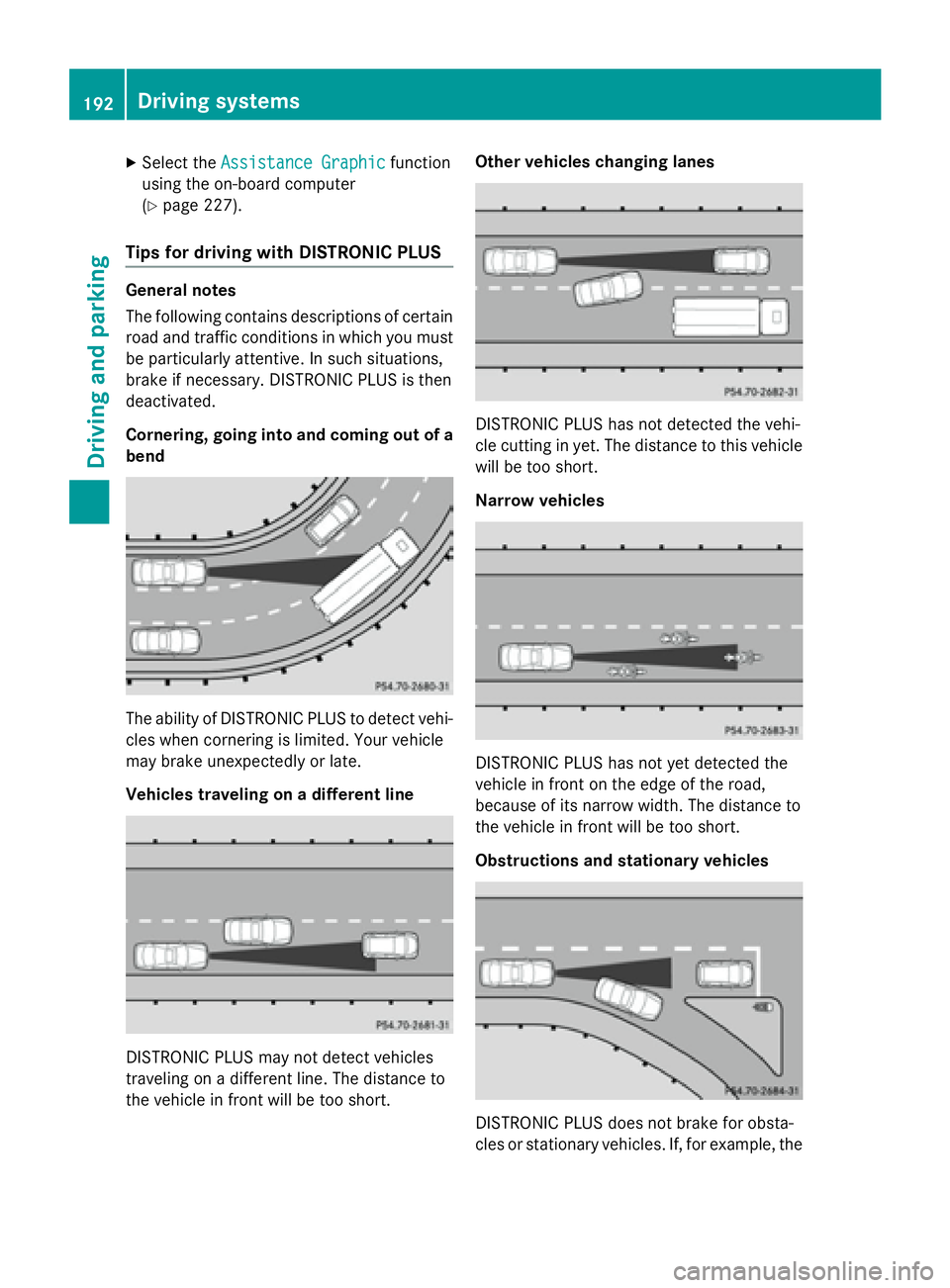
X
Select the Assistance Graphic function
using the on-board computer
( Y
page 227).
Tips for driving with DISTRONIC PLUS General notes
The following contains descriptions of certain
road and traffic conditions in which you must
be particularly attentive. In such situations,
brake if necessary. DISTRONIC PLUS is then
deactivated.
Cornering, going into and coming out of a
bend
The ability of DISTRONIC PLUS to detect vehi-
cles when cornering is limited. Your vehicle
may brake unexpectedly or late.
Vehicles traveling on a different line
DISTRONIC PLUS may not detect vehicles
traveling on a different line. The distance to
the vehicle in front will be too short. Other vehicles changing lanes
DISTRONIC PLUS has not detected the vehi-
cle cutting in yet. The distance to this vehicle
will be too short.
Narrow vehicles
DISTRONIC PLUS has not yet detected the
vehicle in front on the edge of the road,
because of its narrow width. The distance to
the vehicle in front will be too short.
Obstructions and stationary vehicles
DISTRONIC PLUS does not brake for obsta-
cles or stationary vehicles. If, for example, the192
Driving systems
Driving and parking
Page 211 of 390
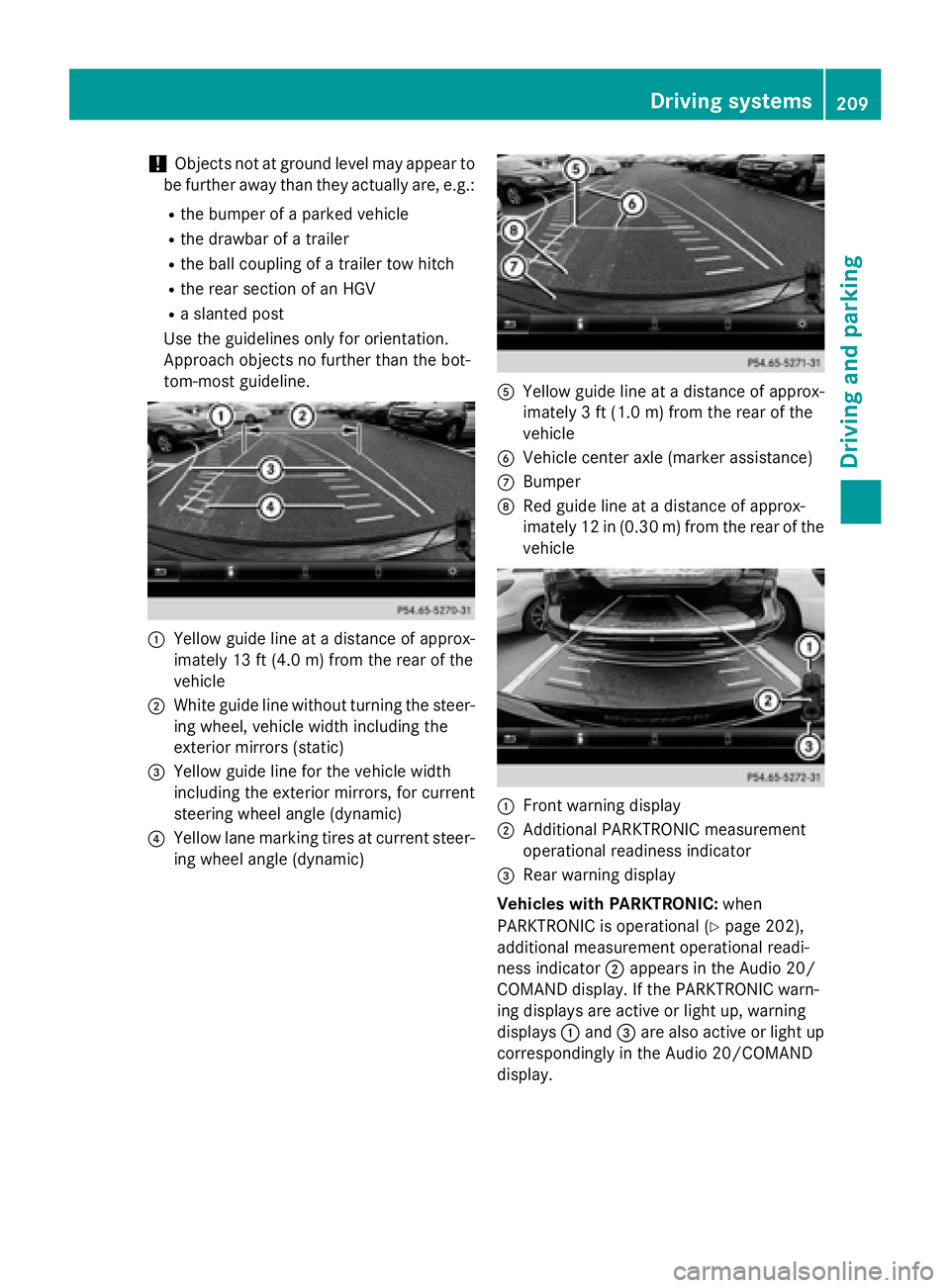
! Objects not at ground level may appear to
be further away than they actually are, e.g.: R
the bumper of a parked vehicle R
the drawbar of a trailer R
the ball coupling of a trailer tow hitch R
the rear section of an HGV R
a slanted post
Use the guidelines only for orientation.
Approach objects no further than the bot-
tom-most guideline.
�C
Yellow guide line at a distance of approx-
imately 13 ft (4.0 m) from the rear of the
vehicle�D
White guide line without turning the steer-
ing wheel, vehicle width including the
exterior mirrors (static)�
Page 212 of 390
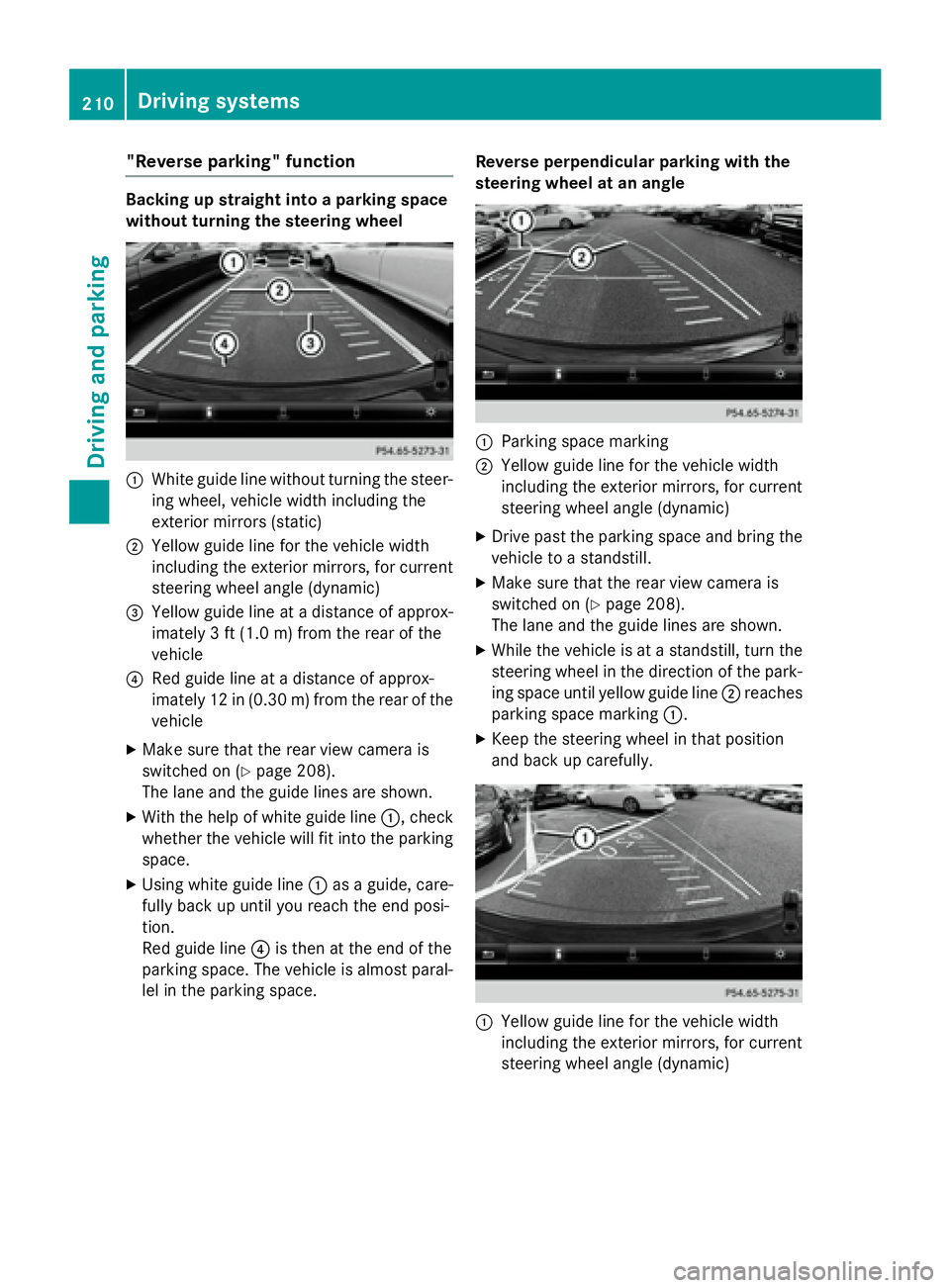
"Reverse parking" function Backing up straight into a parking space
without turning the steering wheel
�C
White guide line without turning the steer-
ing wheel, vehicle width including the
exterior mirrors (static)�D
Yellow guide line for the vehicle width
including the exterior mirrors, for current
steering wheel angle (dynamic)�
Page 343 of 390
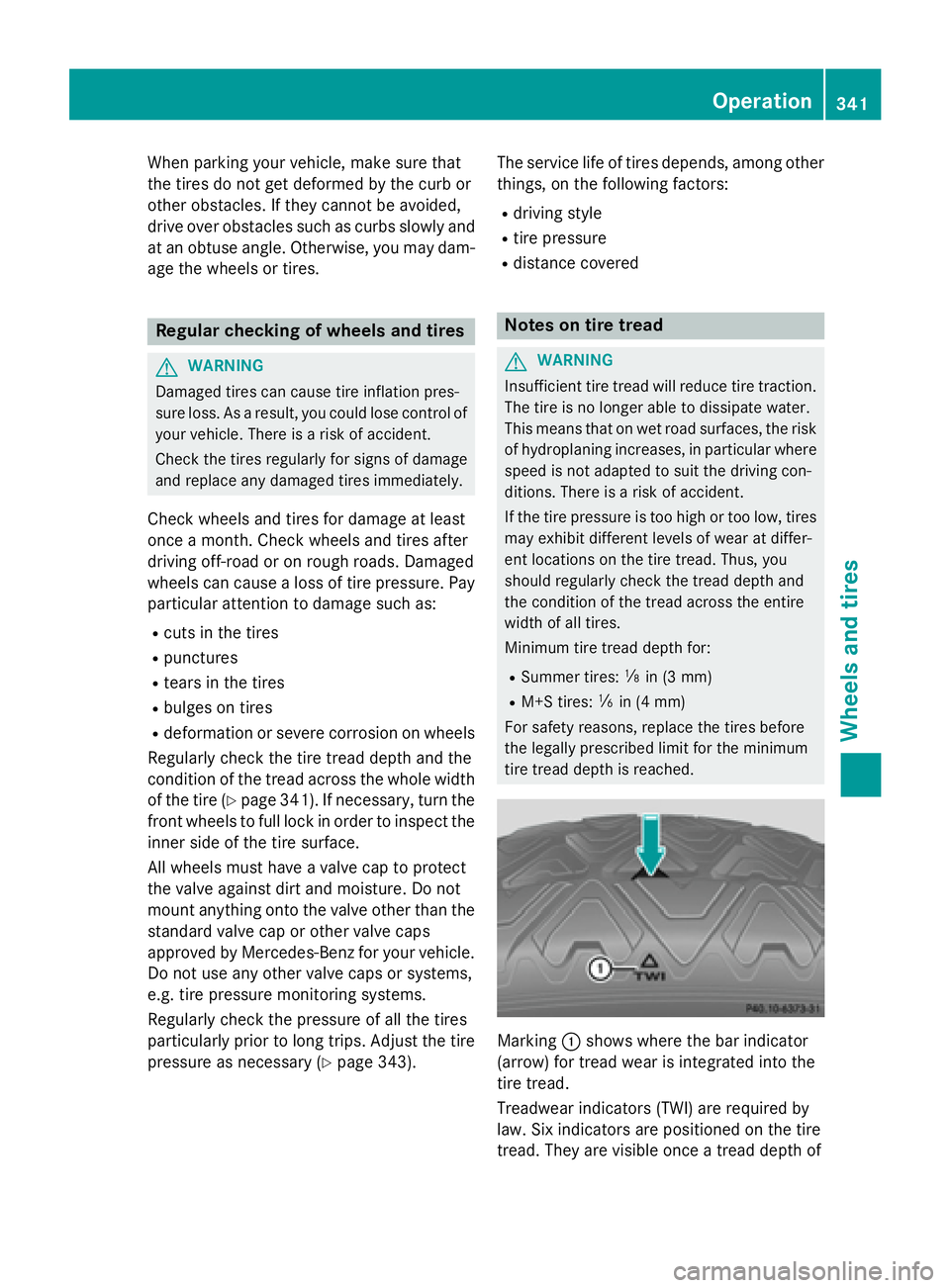
When parking your vehicle, make sure that
the tires do not get deformed by the curb or
other obstacles. If they cannot be avoided,
drive over obstacles such as curbs slowly and
at an obtuse angle. Otherwise, you may dam-
age the wheels or tires.
Regular checking of wheels and tires
G WARNING
Damaged tires can cause tire inflation pres-
sure loss. As a result, you could lose control of
your vehicle. There is a risk of accident.
Check the tires regularly for signs of damage
and replace any damaged tires immediately.
Check wheels and tires for damage at least
once a month. Check wheels and tires after
driving off-road or on rough roads. Damaged
wheels can cause a loss of tire pressure. Pay
particular attention to damage such as: R
cuts in the tires R
punctures R
tears in the tires R
bulges on tires R
deformation or severe corrosion on wheels
Regularly check the tire tread depth and the
condition of the tread across the whole width
of the tire ( Y
page 341). If necessary, turn the
front wheels to full lock in order to inspect the
inner side of the tire surface.
All wheels must have a valve cap to protect
the valve against dirt and moisture. Do not
mount anything onto the valve other than the
standard valve cap or other valve caps
approved by Mercedes-Benz for your vehicle.
Do not use any other valve caps or systems,
e.g. tire pressure monitoring systems.
Regularly check the pressure of all the tires
particularly prior to long trips. Adjust the tire
pressure as necessary ( Y
page 343). The service life of tires depends, among other
things, on the following factors: R
driving style R
tire pressure R
distance covered
Notes on tire tread
G WARNING
Insufficient tire tread will reduce tire traction.
The tire is no longer able to dissipate water.
This means that on wet road surfaces, the risk
of hydroplaning increases, in particular where
speed is not adapted to suit the driving con-
ditions. There is a risk of accident.
If the tire pressure is too high or too low, tires
may exhibit different levels of wear at differ-
ent locations on the tire tread. Thus, you
should regularly check the tread depth and
the condition of the tread across the entire
width of all tires.
Minimum tire tread depth for: R
Summer tires: �
Page 360 of 390
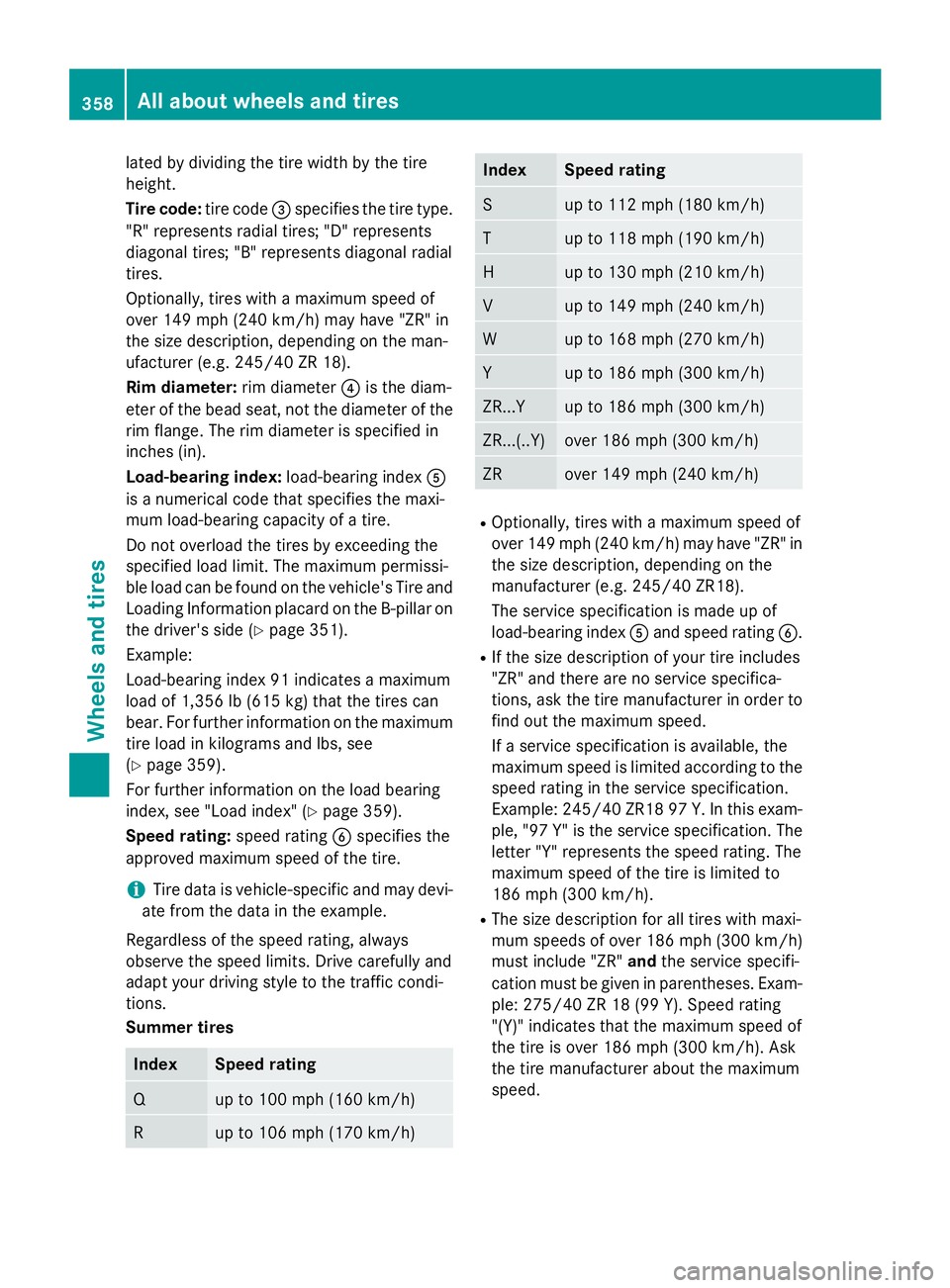
lated by dividing the tire width by the tire
height.
Tire code: tire code �
Page 364 of 390
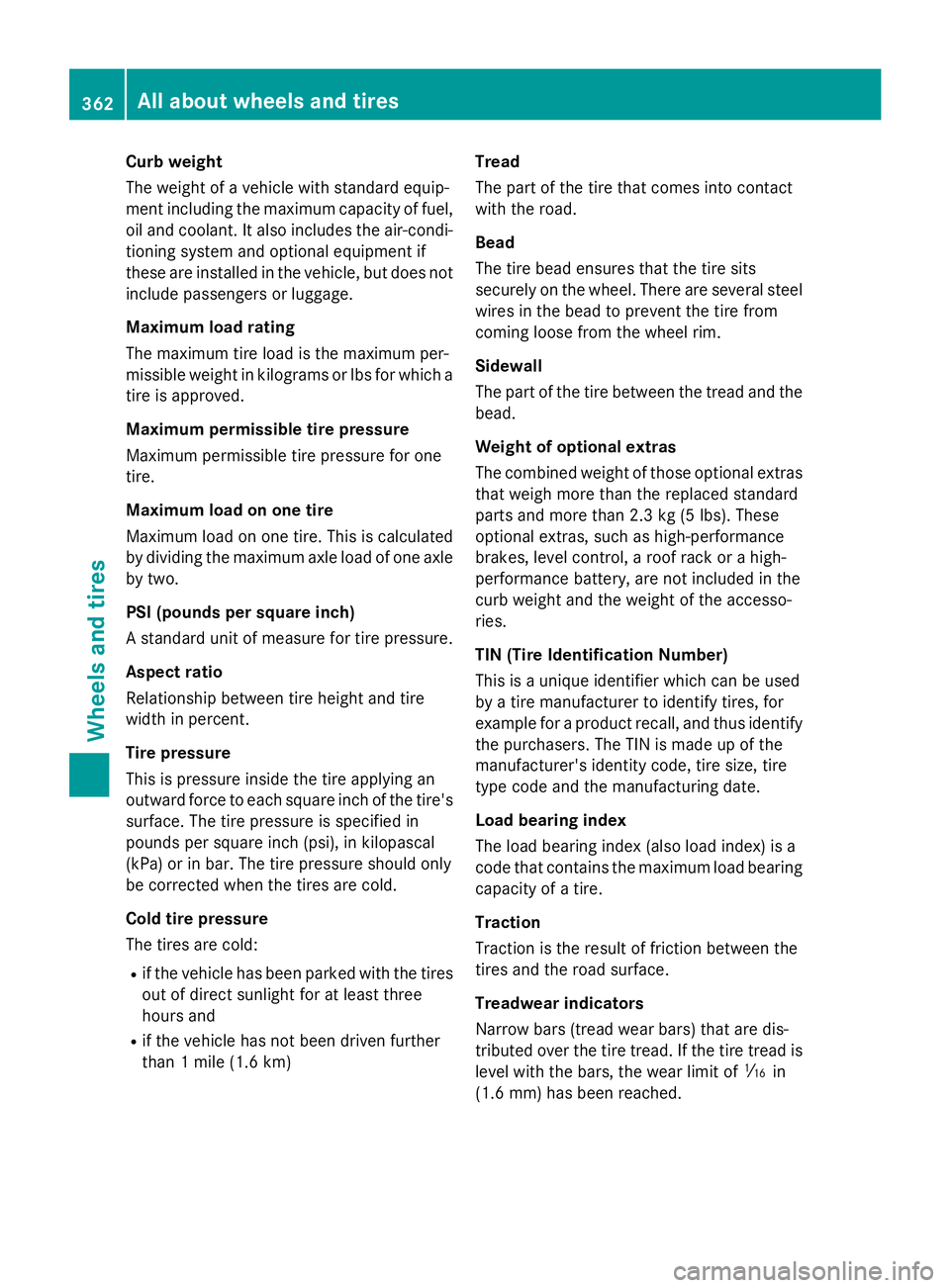
Curb weight
The weight of a vehicle with standard equip-
ment including the maximum capacity of fuel,
oil and coolant. It also includes the air-condi-
tioning system and optional equipment if
these are installed in the vehicle, but does not
include passengers or luggage.
Maximum load rating
The maximum tire load is the maximum per-
missible weight in kilograms or lbs for which a
tire is approved.
Maximum permissible tire pressure
Maximum permissible tire pressure for one
tire.
Maximum load on one tire
Maximum load on one tire. This is calculated
by dividing the maximum axle load of one axle
by two.
PSI (pounds per square inch)
A standard unit of measure for tire pressure.
Aspect ratio
Relationship between tire height and tire
width in percent.
Tire pressure
This is pressure inside the tire applying an
outward force to each square inch of the tire's
surface. The tire pressure is specified in
pounds per square inch (psi), in kilopascal
(kPa) or in bar. The tire pressure should only
be corrected when the tires are cold.
Cold tire pressure
The tires are cold: R
if the vehicle has been parked with the tires
out of direct sunlight for at least three
hours and R
if the vehicle has not been driven further
than 1 mile (1.6 km) Tread
The part of the tire that comes into contact
with the road.
Bead
The tire bead ensures that the tire sits
securely on t h
e wheel. There are several steel
wires in the bead to prevent the tire from
coming loose from the wheel rim.
Sidewall
The part of the tire between the tread and the
bead.
Weight of optional extras
The combined weight of those optional extras
that weigh more than the replaced standard
parts and more than 2.3 kg (5 lbs). These
optional extras, such as high-performance
brakes, level control, a roof rack or a high-
performance battery, are not included in the
curb weight and the weight of the accesso-
ries.
TIN (Tire Identification Number)
This is a unique identifier which can be used
by a tire manufacturer to identify tires, for
example for a product recall, and thus identify
the purchasers. The TIN is made up of the
manufacturer's identity code, tire size, tire
type code and the manufacturing date.
Load bearing index
The load bearing index (also load index) is a
code that contains the maximum load bearing
capacity of a tire.
Traction
Traction is the result of friction between the
tires and the road surface.
Treadwear indicators
Narrow bars (tread wear bars) that are dis-
tributed over the tire tread. If the tire tread is
level with the bars, the wear limit of �
Page 385 of 390
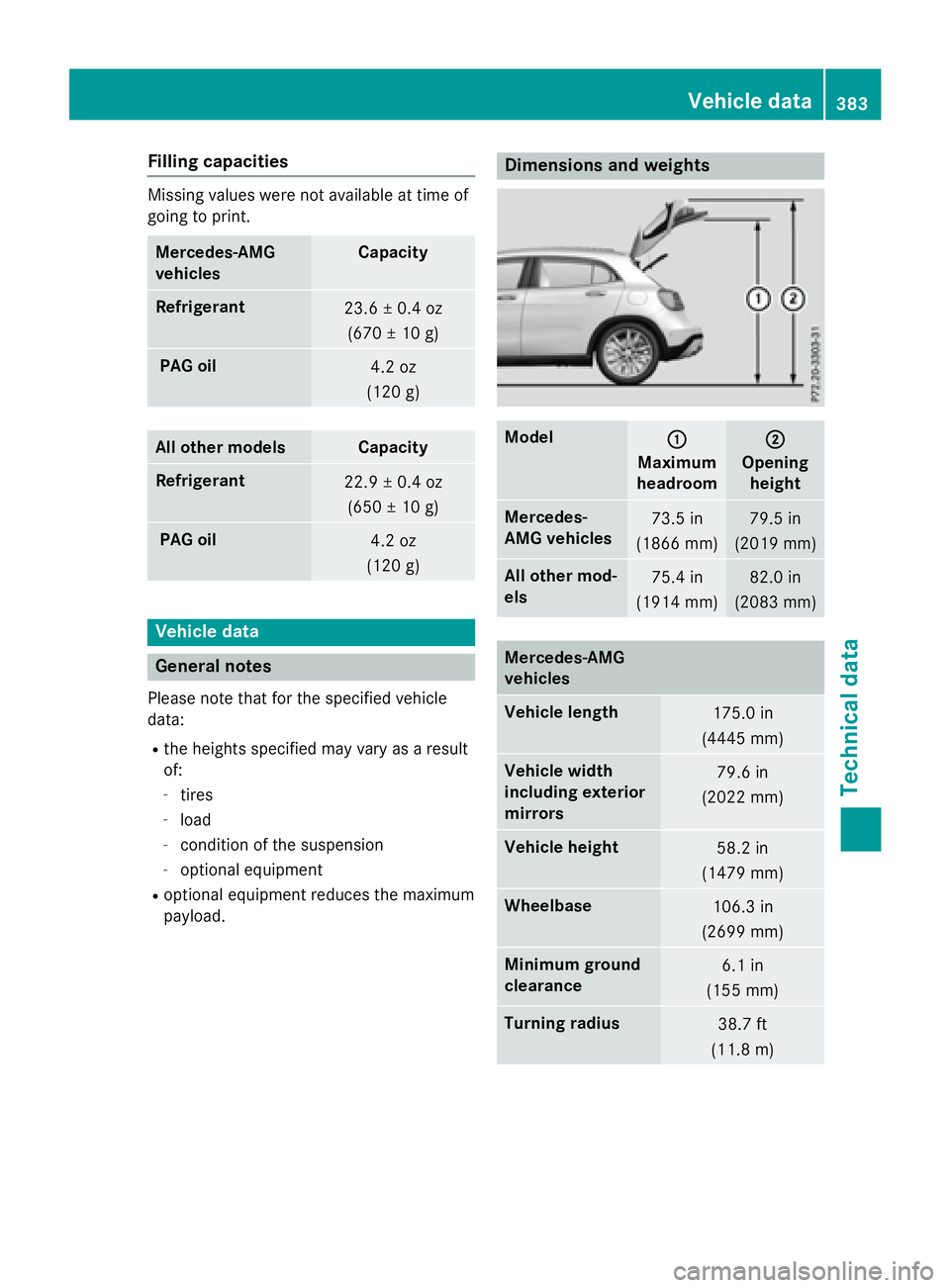
Filling capacities Missing values were not availab le at time of
going to prin t.
Mercedes ‑ AMG
vehicles Capacity
Ref ri gerant
23.6 ± 0.4 oz
(670 ± 10 g)
PAG oil
4.2 oz
(12 0 g)
Al l ot her models Capacity
Refrigerant
22.9 ± 0.4 oz
(650 ± 10 g)
PA G oil
4.2 oz
(120 g)
Vehicle data
General notes
Please note that for the specified vehicle
data: R
the heights specified may vary as a result
of: -
tires -
load -
condition of the suspension -
optional equipment R
optional equipment reduces the maximum
payload. Dimensions and weights
Model
�C
Maximum
headroom �D
Opening
height
Mercedes-
AMG vehicles 73.5 in
(1866 mm) 79.5 in
(2019 mm)
All other mod-
els 75.4 in
(1914 mm) 82.0 in
(2083 mm)
Mercedes ‑ AMG
vehicles
Vehicle length
175.0 in
(4445 mm)
Vehicle width
including exterior
mirrors 79.6 in
(2022 mm)
Vehicle height
58.2 in
(1479 mm)
Wheelbase
106.3 in
(2699 mm)
Minimum ground
clearance 6.1 in
(155 mm)
Turning radius
38.7 ft
(11.8 m)Vehicle data 383
Technical data Z
Page 386 of 390
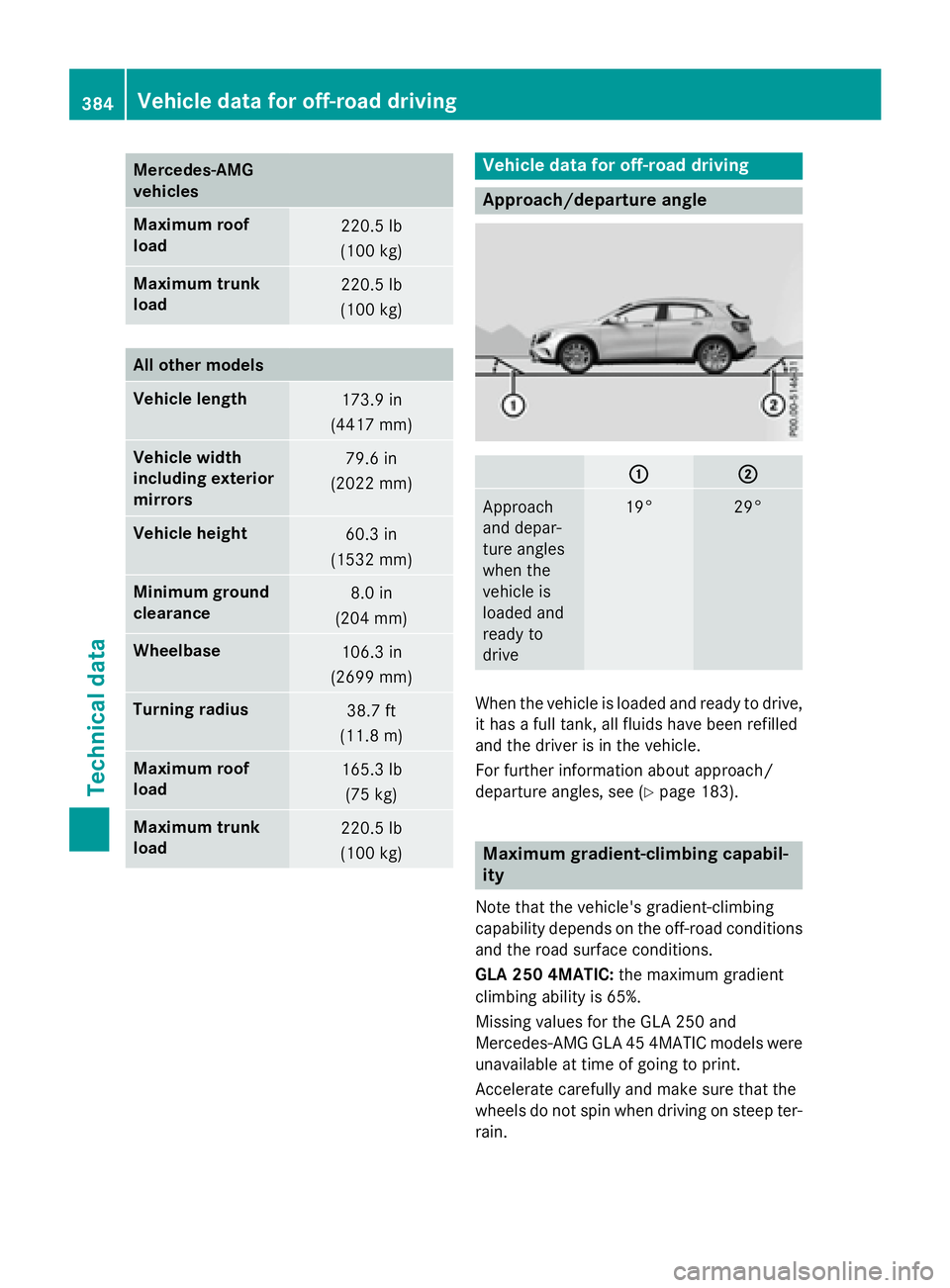
Mercedes ‑ AMG
vehicles
Maximum roof
load 220.5 lb
(100 kg)
Maximum trunk
load 220.5 lb
(100 kg)
All other models
Vehicle length
173.9 in
(4417 mm)
Vehicle width
including exterior
mirrors 79.6 in
(2022 mm)
Vehicle height
60.3 in
(1532 mm)
Minimum ground
clearance 8.0 in
(204 mm)
Wheelbase
106.3 in
(2699 mm)
Turning radius
38.7 ft
(11.8 m)
Maximum roof
load 165.3 lb
(75 kg)
Maximum trunk
load 220.5 lb
(100 kg) Vehicle data for off-road driving
Approach/departure angle
�C �D
Approach
and depar-
ture angles
when the
vehicle is
loaded and
ready to
drive 19° 29°
When the vehicle is loaded and ready to drive,
it has a full tank, all fluids have been refilled
and the driver is in the vehicle.
For further information about approach/
departure angles, see ( Y
page 183).
Maximum gradient-climbing capabil-
ity
Note that the vehicle's gradient-climbing
capability depends on the off-road conditions
and the road surface conditions.
GLA 250 4MATIC: the maximum gradient
climbing ability is 65%.
Missing values for the GLA 250 and
Mercedes-AMG GLA 45 4MATIC models were
unavailable at time of going to print.
Accelerate carefully and make sure that the
wheels do not spin when driving on steep ter-
rain.384
Vehicle data for off-road driving
Technical data